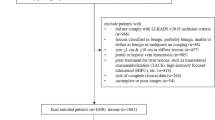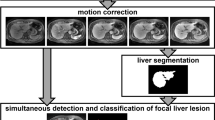Abstract
Purpose
To evaluate whether a three-phase dynamic contrast-enhanced CT protocol, when combined with a deep learning model, has similar accuracy in differentiating hepatocellular carcinoma (HCC) from other focal liver lesions (FLLs) compared with a four-phase protocol.
Methods
Three hundred and forty-two patients (mean age 49.1 ± 10.5 years, range 19–86 years, 65.8% male) scanned with a four-phase CT protocol (precontrast, arterial, portal-venous and delayed phases) were retrospectively enrolled. A total of 449 FLLs were categorized into HCC and non-HCC groups based on the best available reference standard. Three convolutional dense networks (CDNs) with the input of four-phase CT images (model A), three-phase images without portal-venous phase (model B) and three-phase images without precontrast phase (model C) were trained on 80% of lesions and evaluated in the other 20% by receiver operating characteristics (ROC) and confusion matrix analysis. The DeLong test was performed to compare the areas under the ROC curves (AUCs) of A with B, B with C, and A with C.
Results
The diagnostic accuracy in differentiating HCC from other FLLs on test sets was 83.3% for model A, 81.1% for model B and 85.6% for model C, and the AUCs were 0.925, 0.862 and 0.920, respectively. The AUCs of models A and C did not differ significantly (p = 0.765), but the AUCs of models A and B (p = 0.038) and of models B and C (p = 0.028) did.
Conclusions
When combined with a CDN, a three-phase CT protocol without precontrast showed similar diagnostic accuracy as a four-phase protocol in differentiating HCC from other FLLs, suggesting that the multiphase CT protocol for HCC diagnosis might be optimized by removing the precontrast phase to reduce radiation dose.




Similar content being viewed by others
References
Siegel RL, Miller KD, Jemal A (2017) Cancer Statistics, 2017. CA Cancer J Clin 67 (1):7-30
Omata M, Cheng AL, Kokudo N, Kudo M, Lee JM, Jia J, Tateishi R, Han KH, Chawla YK, Shiina S, Jafri W, Payawal DA, Ohki T, Ogasawara S, Chen PJ, Lesmana CRA, Lesmana LA, Gani RA, Obi S, Dokmeci AK, Sarin SK (2017) Asia-Pacific clinical practice guidelines on the management of hepatocellular carcinoma: a 2017 update. Hepatol Int 11 (4):317-370
Hennedige T, Venkatesh SK (2016) Advances in computed tomography and magnetic resonance imaging of hepatocellular carcinoma. World J Gastroenterol 22 (1):205-220
Marrero JA, Kulik LM, Sirlin CB, Zhu AX, Finn RS, Abecassis MM, Roberts LR, Heimbach JK (2018) Diagnosis, Staging, and Management of Hepatocellular Carcinoma: 2018 Practice Guidance by the American Association for the Study of Liver Diseases. Hepatology 68 (2):723-750
European Association for the Study of the Liver. Electronic address eee, European Association for the Study of the L (2018) EASL Clinical Practice Guidelines: Management of hepatocellular carcinoma. J Hepatol 69 (1):182-236
Ayuso C, Rimola J, Vilana R, Burrel M, Darnell A, Garcia-Criado A, Bianchi L, Belmonte E, Caparroz C, Barrufet M, Bruix J, Bru C (2018) Diagnosis and staging of hepatocellular carcinoma (HCC): current guidelines. Eur J Radiol 101:72-81
Goldman LW (2007) Principles of CT: radiation dose and image quality. J Nucl Med Technol 35 (4):213-225; quiz 226-218
McCollough CH, Primak AN, Braun N, Kofler J, Yu L, Christner J (2009) Strategies for reducing radiation dose in CT. Radiol Clin North Am 47 (1):27-40
Ngo AV, Winant AJ, Lee EY, Phillips GS (2018) Strategies for Reducing Radiation Dose in CT for Pediatric Patients: How We Do It. Semin Roentgenol 53 (2):124-131
Wenz H, Maros ME, Meyer M, Gawlitza J, Forster A, Haubenreisser H, Kurth S, Schoenberg SO, Groden C, Henzler T (2016) Intra-individual diagnostic image quality and organ-specific-radiation dose comparison between spiral cCT with iterative image reconstruction and z-axis automated tube current modulation and sequential cCT. Eur J Radiol Open 3:182-190
Doyle DJ, O’Malley ME, Jang HJ, Jhaveri K (2007) Value of the unenhanced phase for detection of hepatocellular carcinomas 3 cm or less when performing multiphase computed tomography in patients with cirrhosis. J Comput Assist Tomogr 31 (1):86-92
Dahlman P, van der Molen AJ, Magnusson M, Magnusson A (2012) How much dose can be saved in three-phase CT urography? A combination of normal-dose corticomedullary phase with low-dose unenhanced and excretory phases. AJR Am J Roentgenol 199 (4):852-860
Mohammadinejad P, Ehman EC, Vasconcelos RN, Venkatesh SK, Hough DM, Lowe R, Lee YS, Nehra A, Dirks S, Holmes DR, 3rd, Carter RE, Schmidt B, Halaweish AF, McCollough CH, Fletcher JG (2020) Prior iterative reconstruction (PIR) to lower radiation dose and preserve radiologist performance for multiphase liver CT: a multi-reader pilot study. Abdom Radiol (NY) 45 (1):45-54
Coudray N, Ocampo PS, Sakellaropoulos T, Narula N, Snuderl M, Fenyo D, Moreira AL, Razavian N, Tsirigos A (2018) Classification and mutation prediction from non-small cell lung cancer histopathology images using deep learning. Nat Med 24 (10):1559-1567
Norman B, Pedoia V, Noworolski A, Link TM, Majumdar S (2018) Applying Densely Connected Convolutional Neural Networks for Staging Osteoarthritis Severity from Plain Radiographs. J Digit Imaging
Gong H, Yu L, Leng S, Dilger SK, Ren L, Zhou W, Fletcher JG, McCollough CH (2019) A deep learning- and partial least square regression-based model observer for a low-contrast lesion detection task in CT. Med Phys 46 (5):2052-2063
Azer SA (2019) Deep learning with convolutional neural networks for identification of liver masses and hepatocellular carcinoma: A systematic review. World J Gastrointest Oncol 11 (12):1218-1230
Yasaka K, Akai H, Abe O, Kiryu S (2018) Deep Learning with Convolutional Neural Network for Differentiation of Liver Masses at Dynamic Contrast-enhanced CT: A Preliminary Study. Radiology 286 (3):887-896
Trivizakis E, Manikis GC, Nikiforaki K, Drevelegas K, Constantinides M, Drevelegas A, Marias K (2019) Extending 2-D Convolutional Neural Networks to 3-D for Advancing Deep Learning Cancer Classification With Application to MRI Liver Tumor Differentiation. IEEE J Biomed Health Inform 23 (3):923-930
Bharti P, Mittal D, Ananthasivan R (2018) Preliminary Study of Chronic Liver Classification on Ultrasound Images Using an Ensemble Model. Ultrason Imaging 40 (6):357-379
Jian W, Ju H, Cen X, Cui M, Zhang H, Zhang L, Wang G, Gu L, Zhou W (2019) Improving the malignancy characterization of hepatocellular carcinoma using deeply supervised cross modal transfer learning for non-enhanced MR. Conf Proc IEEE Eng Med Biol Soc 2019:853-856
Sato M, Morimoto K, Kajihara S, Tateishi R, Shiina S, Koike K, Yatomi Y (2019) Machine-learning Approach for the Development of a Novel Predictive Model for the Diagnosis of Hepatocellular Carcinoma. Sci Rep 9 (1):7704
Furlan A, Marin D, Vanzulli A, Patera GP, Ronzoni A, Midiri M, Bazzocchi M, Lagalla R, Brancatelli G (2011) Hepatocellular carcinoma in cirrhotic patients at multidetector CT: hepatic venous phase versus delayed phase for the detection of tumour washout. Brit J Radiol 84 (1001):403-412
Chen LC, Papandreou G, Kokkinos I, Murphy K, Yuille AL (2018) DeepLab: Semantic Image Segmentation with Deep Convolutional Nets, Atrous Convolution, and Fully Connected CRFs. Ieee T Pattern Anal 40 (4):834-848
Nakao S, Tanabe M, Okada M, Furukawa M, Iida E, Miyoshi K, Matsunaga N, Ito K (2019) Liver imaging reporting and data system (LI-RADS) v2018: comparison between computed tomography and gadoxetic acid-enhanced magnetic resonance imaging. Jpn J Radiol 37 (9):651-659
Zhang YD, Zhu FP, Xu X, Wang Q, Wu CJ, Liu XS, Shi HB (2016) Liver Imaging Reporting and Data System:: Substantial Discordance Between CT and MR for Imaging Classification of Hepatic Nodules. Acad Radiol 23 (3):344-352
Basha MAA, AlAzzazy MZ, Ahmed AF, Yousef HY, Shehata SM, El Sammak D, Fathy T, Obaya AA, Abdelbary EH (2018) Does a combined CT and MRI protocol enhance the diagnostic efficacy of LI-RADS in the categorization of hepatic observations? A prospective comparative study. Eur Radiol 28 (6):2592-2603
Elsayes KM, Fowler KJ, Chernyak V, Elmohr MM, Kielar AZ, Hecht E, Bashir MR, Furlan A, Sirlin CB (2019) User and system pitfalls in liver imaging with LI-RADS. J Magn Reson Imaging 50 (6):1673-1686
Corwin MT, Fananapazir G, Jin M, Lamba R, Bashir MR (2016) Differences in Liver Imaging and Reporting Data System Categorization Between MRI and CT. AJR Am J Roentgenol 206 (2):307-312
Papadatos D, Fowler KJ, Kielar AZ, Cui J, Sirlin CB (2018) Cirrhosis and LI-RADS. Abdom Radiol (NY) 43 (1):26-40
Han Y, Chen J, Zhang L, Kuang S, Xie S, Sirlin CB, Wang J Diagnostic Accuracy of Liver Imaging Reporting and Data System (LI-RADS) for HCC in Non-cirrhotic Patients with Chronic Hepatitis. In: Radiological Society of North America 2019 Scientific Assembly and Annual Meeting, Chicago IL, 2019.
Kim T, Murakami T, Takahashi S, Tsuda K, Tomoda K, Narumi Y, Oi H, Sakon M, Nakamura H (1999) Optimal phases of dynamic CT for detecting hepatocellular carcinoma: evaluation of unenhanced and triple-phase images. Abdom Imaging 24 (5):473-480
Iannaccone R, Laghi A, Catalano C, Rossi P, Mangiapane F, Murakami T, Hori M, Piacentini F, Nofroni I, Passariello R (2005) Hepatocellular carcinoma: Role of unenhanced and delayed phase multi-detector row helical CT in patients with cirrhosis. Radiology 234 (2):460-467
Funding
The scientific guarantor of this publication is Jin Wang. This study has received funding by (1) National Natural Science Foundation of China (Grant No. 91959118); (2) Science and Technology Program of Guangzhou, China (Grant No. 201704020016); (3) SKY Radiology Department International Medical Research Foundation of China (Grant No. Z-2014-07-1912-15); (4) Clinical Research Foundation of the 3rd Affiliated Hospital of Sun Yat-sen University (Grant No. YHJH201901).
Author information
Authors and Affiliations
Corresponding author
Ethics declarations
Conflict of interest
Professor Claude B. Sirlin declares financial disclosures: Educational materials royalties: Wolters Kluwer. Research grants: Foundation of NTH, Bayer, GE, Gilead, Philips, Siemens. Consulting: Blade, Boehringer, Epigenomics. Consulting under auspices of UC: AMRA, BMS, Exact Sciences, GE Digital, IBM-Watson. Core lab services: Enanta, Gilead, ICON, Intercept, Nusirt, Shire, Synageva, Takeda. Non-Financial disclosures: Co-Chair, LI-RADS Steering Committee. Co-Chair, LI-RADS Lexicon & Writing Group. Professor Claude B. Sirlin received no grant funding. Professor Jin Wang declares financial disclosures: Research grants: National Natural Science Foundation of China Grant 91959118 (JW), Science and Technology Program of Guangzhou, China 201704020016 (JW), SKY Radiology Department International Medical Research Foundation of China Z-2014-07-1912-15 (JW), Clinical Research Foundation of the 3rd Affiliated Hospital of Sun Yat-sen University YHJH201901 (JW). Non-Financial disclosures: Member, LI-RADS international working group. Member, ISMRM Education committee. Other authors declare that there are no financial or other relationships that might lead to a conflict of interest of the present article. All authors have reviewed the final version of the manuscript and approved it for publication.
Ethics approval
Our institutional review board approved this retrospective study and waived the need for informed consent. This article did not contain any studies with animals.
Additional information
Publisher's Note
Springer Nature remains neutral with regard to jurisdictional claims in published maps and institutional affiliations.
Rights and permissions
About this article
Cite this article
Shi, W., Kuang, S., Cao, S. et al. Deep learning assisted differentiation of hepatocellular carcinoma from focal liver lesions: choice of four-phase and three-phase CT imaging protocol. Abdom Radiol 45, 2688–2697 (2020). https://doi.org/10.1007/s00261-020-02485-8
Published:
Issue Date:
DOI: https://doi.org/10.1007/s00261-020-02485-8




